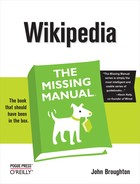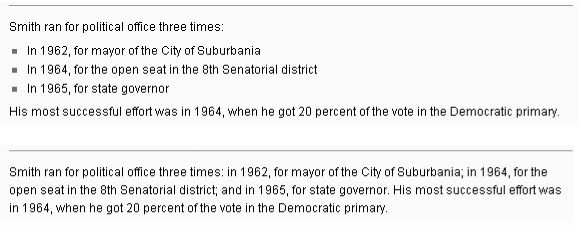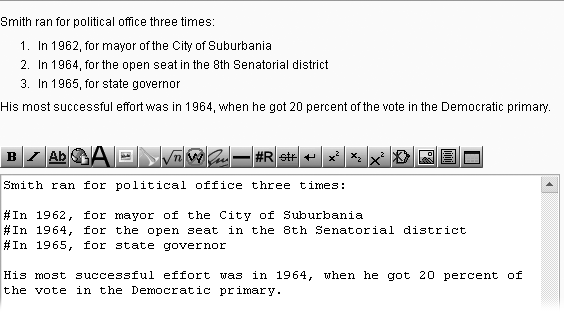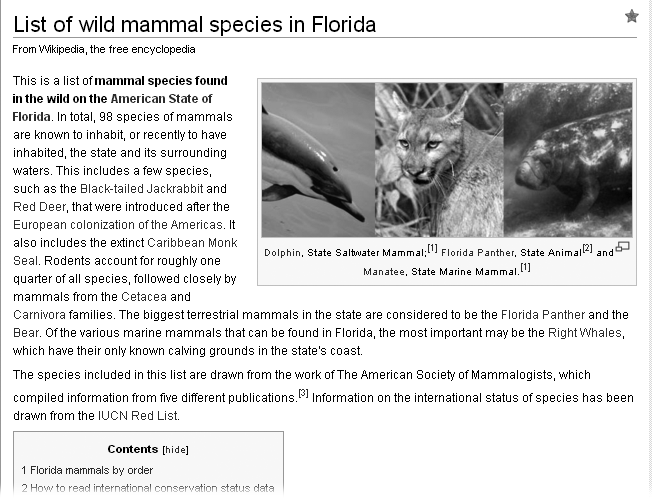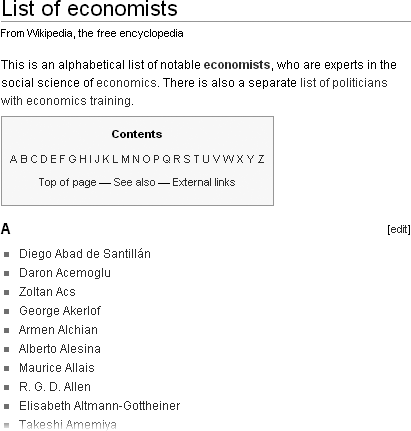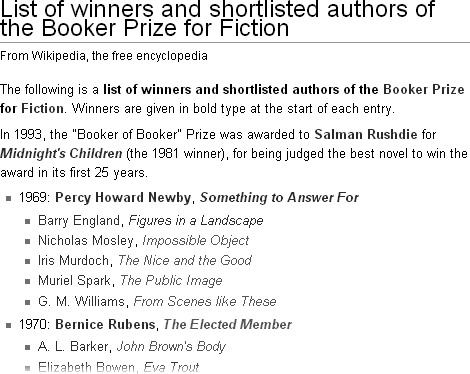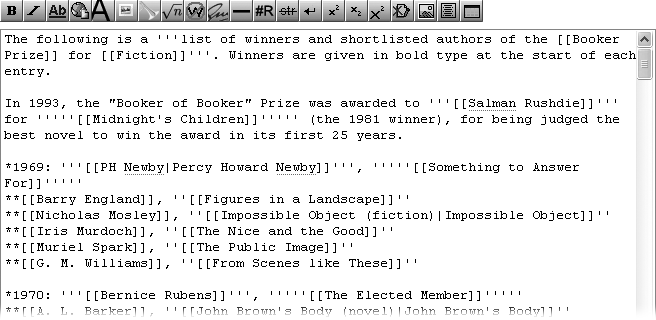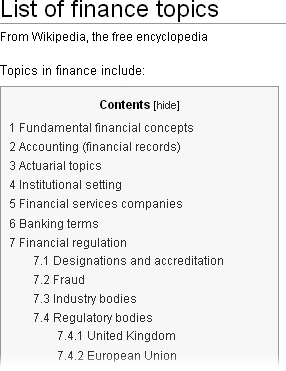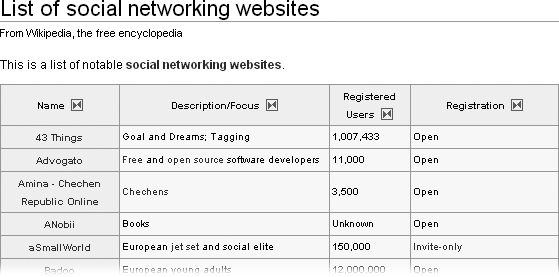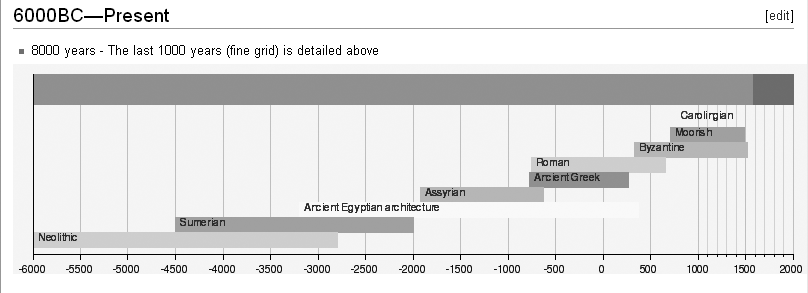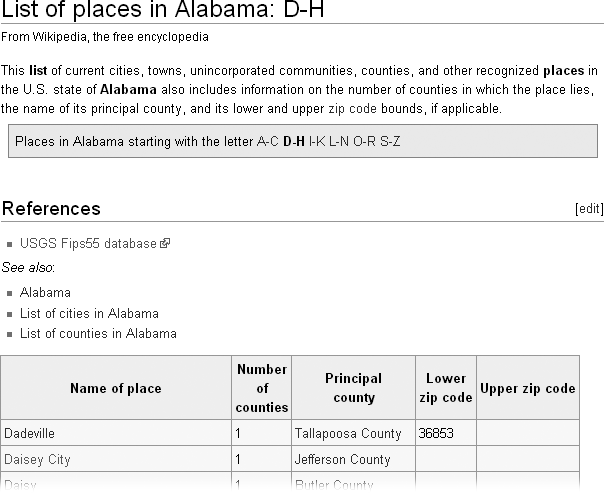Lists and tables are two different ways to format multiple, similar items on a page. Lists and HTML tables go back to Wikipedia’s early days. The current wikicode tables (Editing Tables), which you can edit more easily and even sort, came later.
You’ll find many more lists than tables on Wikipedia. For example, the External links sections that appear in almost every Wikipedia article are lists. Tables are less common, but they’re making up ground fast. You’ll probably have occasion to edit a table, if not make one. This chapter shows you how to create and edit both lists and tables.
Wikipedia has two kinds of lists: embedded lists (a list within a larger article), and standalone lists (an article that’s only a list). An example of the latter is the article List of colors. Embedded lists are easier to grasp, both conceptually and in terms of formatting, although you won’t have trouble understanding articles that are lists.
Lists are easy to create, but sometimes you really shouldn’t. Before you make a list, read the first part of this section and think about whether you could present the information in narrative form. When you’re ready to make a list, flip to How to create a list to see how to create the underlying wikitext.
Wikipedia articles are intended to be narratives, not guides or places for stockpiling information, as explained at What Wikipedia is not (shortcut: WP:NOT). So first ask yourself, when you see a list in an article, or when you’re considering adding a list to an article, whether that list even belongs in an article. Some cases are very clear: A list of links in the External links section of an article absolutely needs to be there, in list format. But in an article about a nonprofit organization, a full list of the 45 members of its advisory board would be a violation of WP:NOT.
Some editors feel that the more information an article contains, the better. Long lists tend to prove the opposite: They take up valuable editing time to create and maintain, and they’re distracting. In the nonprofit organization example, readers who are really interested in who’s on the advisory board can find out by going to the organization’s Web site. If there are a few notable board members, you can simply mention them in a quick sentence. (“The advisory board includes Michael Dell, Al Gore, and David Hasselhoff.”)
If you decide that some or all the items in a list belong in a Wikipedia article, your next decision is whether to use a formal list; that is, one using wiki markup. For example, Figure 14-1 shows two ways of presenting the same information, with a list and without.
Figure 14-1. Shown are two ways of including the same information in an article: in list format (top) and narrative format (bottom). In this case, narrative is better. It maintains the article’s flow and takes up less space.
Popular opinion at Wikipedia is against lists in articles, particularly numbered lists, if narrative is an alternative. But sometimes a bulleted list can break up what would otherwise be an overly large, gray mass of text, particularly if the topic is dry or complex. (Put differently, sometimes bulleted narrative makes sense.) You’ll find a nuanced discussion of bulleted lists versus fully narrative text at the guideline Wikipedia:Embedded list (shortcut WP:EMBED).
Note
Sometimes the term “list” refers to something more complicated—a presentation of similar, multiple items in a multi-column format. That’s actually a table, and you can read about them on Editing and Creating Tables.
To create a list in Wikipedia, you add special characters to the text of the list items. The special characters tell the software how to format the list onscreen. The combination of text and formatting characters is called wikitext. In Figure 14-2, you can see the underlying wikitext that creates the bulleted list in Figure 14-1.
Figure 14-2. The wikitext for the bulleted list in Figure 14-1 is very simple—an asterisk at the beginning of each item in the list.
To create a list, simply go into edit mode, type or paste the list items (each on a separate line), and then type an asterisk (*) at the beginning of each list item for a bulleted list or a pound sign (#) to create a numbered list. Figure 14-3 shows the same list used in previous examples, this time as a numbered list.
Figure 14-3. Putting pound (#) signs at the beginning of a line of text will number that line. Numbering is rare in articles, but it’s handy (and common) on discussion pages. Typos can wreak havoc in wikitext numbered lists. For example, if you put a blank line between items, the numbering starts over.
Tip
The technical page Help:List describes more than a dozen ways to modify lists: indentation, splitting lists, Roman numerals, extra indentation, a specified starting value for a numbered list, multicolumn bulleted lists, and more. You don’t need to know any of them for editing articles. You might see the more fancy options on discussion pages, but rarely even there.
Lists often begin as sections of an article, and then expand. At some point, a list can become too long to be part of an article, and needs to be spun off as a separate “List of” article. On Creating a daughter article, you can find step by step instructions for spinning off a section into an article of its own (in fact, the example in that section is a list).
Standalone lists are Wikipedia articles that are basically one big list, usually consisting of links to articles in a particular subject area; for example, North American mammals, or economists, or events listed chronologically. The titles of these articles almost always begin with the phrase words “List of” or “Timeline of”. (There’s an occasional “Glossary of”, which is a sort of list, and a few pages called “Graphical timeline of”, as well.) Standalone lists, like other articles, are subject to Wikipedia’s content policies, including verifiability, no original research, and neutral point of view.
Lists need to be about notable things. Red links (wikilinks to non-existent articles, which show as red instead of blue) are allowed in lists, but only in small amounts. A preponderance of red links probably means that the subject isn’t notable enough to be on Wikipedia. For example, an article called List of high school science teachers in New York City, with entries that include only a couple of blue links, would make the article at best a guide and at worst a vanity article, both of which are disallowed by WP:NOT.
Lists that are too general or too broad in scope have little value. For example, a list of brand names would be far too long to be useful (it would also require Herculean efforts by a fairly large number of editors to properly maintain it). Lists that are too specific are also a problem. For example, an article List of one-eyed horse thieves from Montana would be of little interest to anyone except the person making the list.
Lists are prone to suffering from unclear criteria or a non-neutral point of view, which may actually be the same problem. Examples include List of exploitative companies, List of authoritarian leaders, and even List of famous Brazilian people. (Change “famous” in the last example to “notable,” and the problem goes away, since Wikipedia has notability criteria for articles about people, for the purposes of determining if they’re entitled to a separate article in Wikipedia.) A related problem—of point of view—occurs when an article consists of lists of arguments for and against some particular contention or position. Such articles are not acceptable per the guideline Wikipedia:Pro and con lists (shortcut: WP:PACL).
As with everything else at Wikipedia, there isn’t universal agreement about exactly what’s acceptable as the subject of a list. One argument, mentioned in the essay Wikipedia:Listcruft (shortcut: WP:LC), states that the only legitimate “List of” articles start out as sections of existing narrative articles, and are only broken out when they become disproportionately long for the original article. (Essays are opinions, not policy.)
Note
As an editor, treat problematical lists exactly like other problem articles, as described in Chapter 18. If you see what looks like a bad list, you might want to post a question on the talk page of the guideline Wikipedia:Lists (stand-alone lists) (shortcut: WP:SAL) before formally proposing the list for deletion.
As of mid-2008, over 800 articles had earned the honor of being designated Featured lists, with roughly 20 to 40 more lists being so designated each month. Figure 14-4 shows some of the criteria. The full criteria include complying with the Manual of Style (WP:MOS) and standards of any relevant WikiProject, and making sure any images are appropriately captioned and not copyright violations.
Figure 14-4. The criteria for evaluating whether an article gets to be a Featured list is at Wikipedia:Featured list criteria (shortcut: WP:WIAFL). You can use the criteria as a checklist to improve a list that interests you. When you think your list is good enough, you can submit it to a review to see if it earns the Featured list designation.
Looking at articles designated as Featured lists can show you the variety of formats used for lists, and the astounding quality achieved by some. Figure 14-5 shows one example.
Figure 14-5. The article List of wild mammal species in Florida has been designated as a Featured list. It’s an amazing collection of sortable lists, with pictures and well over a hundred footnotes for those interested in more information. The star in the upper-right corner indicates that it’s a Wikipedia featured page. The same star appears on Featured Articles and Featured Portals.
A list article in its simplest form consists of an introductory sentence or two, followed by an alphabetized bullet list of links to (mostly) existing Wikipedia articles. It resembles a category page.
Note
Wikipedia:Categories, lists, and navigational templates (shortcut: WP:CLN) discusses the differences between list articles and category pages. Chapter 18 (Categories, Lists, and Navigation Templates) goes into detail about the advantages and disadvantages of the two approaches.
If you look at the wikicode for articles that are lists, you find a number of different things:
Narrative. The initial section of an article that’s a list explains what the list is about, in the usual narrative format. Narrative can also appear in other places—the article in Figure 14-5 has not only a long lead section but also a number of narrative paragraphs at the beginning of sections. Some articles that have a name beginning with “List of”, such as List of Pokémon (481-493) are a collection of information that might at some later point become individual articles, and are entirely narrative. (On the other hand, the article could be renamed Pokémon species 481 to 493.)
Bulleted lists using asterisks. You saw an example of bulleted lists at the top of Figure 14-1, with wikitext in Figure 14-2. That’s an embedded list, but the code is exactly the same for standalone lists. That kind of bulleted list created with asterisks is the oldest form of Wikipedia list, and it’s still the most common for standalone lists, since it’s so easy to use. You can see an example in Figure 14-6.
Figure 14-6. The article List of economists is a simple bulleted list of wikilinks. It resembles a category page (Chapter 17) so much that pages like this one have been the subject of fights between proponents of categories (who want to delete lists like this) and those arguing that lists are just as good, if not superior. For more information, see Categories, Lists, and Navigation Templates.
The bulleted list has a couple of variants. One, called an annotated list, adds a bit of information after each link. If Figure 14-6 were an annotated list, for example, the entry for Diego Abad de Santillán might have “(1897–1983), Spain” after the wikilink. A second variant is a bulleted list with some items indented, as a sort of subcategorization. Figure 14-7 shows an example of a bulleted list with indented items.
Figure 14-7. Here’s the beginning of the article List of winners and shortlisted authors of the Booker Prize for Fiction. It’s an example of indented bulleted paragraphs within articles.
The formatting for the indented, bulleted paragraphs in Figure 14-7 is straightforward, as shown in Figure 14-8.
Figure 14-8. You indent bulleted paragraphs simply by putting two asterisks at the beginning of a line, rather than one. This arrangement looks nicer than colon indenting, but it’s more fragile. If you make a mistake and have a blank line just above the double asterisks, then the viewable version of the page shows two bullets at the beginning of the line, not one indented bullet.
The bulleted list in Figure 14-6 is alphabetical; the one in Figure 14-7 is chronological. (Lists whose titles begin “Timeline of” are, of course, always chronological.) Bulleted lists can also be hierarchical, as in Figure 14-9.
Figure 14-9. The article List of finance topics is arranged hierarchically. This scheme is a bit more challenging for editors, but it helps readers comprehend what otherwise might be a long alphabetized list. It also helps readers find related articles that wouldn’t be obvious in an alphabetical list.
A table is a third kind of wikitext (besides narrative and bulleting) used for lists. Figure 14-10 shows an example. Tables can be the bulk of a list article or just part of a narrative article. (“Editing and Creating Tables” on Editing and Creating Tables has the full story.)
Figure 14-10. The article List of social networking websites consists primarily of a sortable table, which lets readers reorganize the table to better find what they want. (For more on sorting tables, see Sortable tables.)
A fourth kind of formatting for lists uses a graphical timeline. Such lists are usually named “Timeline of X,” or “Graphical timeline of X”. Figure 14-11 has an example of a graphical timeline that functions as a list.
Figure 14-11. Here’s one of three timelines that make up the article Timeline of architectural styles. It uses the <timeline> tag syntax, sometimes called EasyTimeline syntax. Graphical timelines are relatively rare, but you can read about them at Wikipedia:Timeline (shortcut: WP:TIMEL) and Help:EasyTimeline syntax.
Note
Timelines also appear in non-list articles, often as navigation templates. (Some of these timelines actually are templates, with a different syntax from the newer <timeline> tag syntax.)
Finally, you can split long lists using a navigation template that lets readers know that though they’re looking at just one article, that’s part of the a set of related articles that together make up a full list. Figure 14-12 gives an example.
Figure 14-12. The article List of places in Alabama: D-H. The box near the top of the article, with text that begins “Places in Alabama”, is there because the underlying wikitext includes the template {{List of places in Alabama}}. That template also appears at the top of the other five lists (A-C, I-K, L-N, O-R, and S-Z) that comprise a single list. This navigational template makes it easy for the reader to get to any of these six parts, although they’re separate articles.
Note
Figure 14-12 is another example of a list that’s basically a table. Unlike Figure 14-10, however, this table isn’t sortable.
